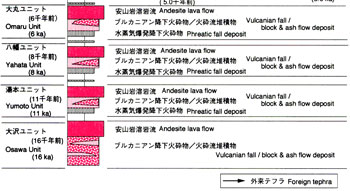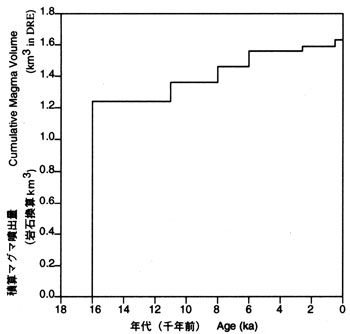Nasu Volcano
Introduction / Geology of Nasu volcano and environs / Outline of Nasu volcano
Rocks of Nasu Volcano
Eruptive history and mode of eruption of Chausudake Volcano
Eruptions of 1408 - 1410 / Eruptions of recent times
Surveillance of volcanic activities / Prediction of future activities
Acknowledgments / References
![]() PREV
PREV ![]() NEXT
NEXT
Eruptive history and mode of eruption of Chausudake Volcano
Ejecta of Chausudake Volcano consist of six units accompanied with eruptions of magma and over twelve units with phreatic eruptions unaccompanied with magma ( ![]() Fig. 4 ). Eruptions accompanied with magma are known in about 160,000 yBP ( Osawa unit ), in 110,000 yBP ( Yumoto unit ), in 8,000 yBP ( Yahata unit ), 6,000 yBP ( Omaru unit ), 2,600 yBP ( Minenochaya unit ), and at the beginning of 15 century ( 1408-1410 unit ). Many deposits of phreatic eruptions originated from Numazawa Volcano 50 km NW of Chausudake, following deposition of Numazawa-Lake Numazawa pumice fall about 5,000 years ago, are identified. When the individual eruption unit of Chausudake ejecta is converted to rock-equivalent volume ( volume of ejecta converted as volume of rock with density of 2.5 kg / cm3 ), Osawa unit is identified to be a large eruption as having more than 1 km3rock-equivalent volume. Other magmatic eruptions having 10-1 - 10-2 km3 are defined as medium scale, phreatic eruptions having 10-2 - 10-3 km3 as small scale eruptions the deposits of which are identifiable in the field, and phreatic eruptions having less than 10-4 km3 as micro scale eruptions the deposits of which are not identifiable.
Fig. 4 ). Eruptions accompanied with magma are known in about 160,000 yBP ( Osawa unit ), in 110,000 yBP ( Yumoto unit ), in 8,000 yBP ( Yahata unit ), 6,000 yBP ( Omaru unit ), 2,600 yBP ( Minenochaya unit ), and at the beginning of 15 century ( 1408-1410 unit ). Many deposits of phreatic eruptions originated from Numazawa Volcano 50 km NW of Chausudake, following deposition of Numazawa-Lake Numazawa pumice fall about 5,000 years ago, are identified. When the individual eruption unit of Chausudake ejecta is converted to rock-equivalent volume ( volume of ejecta converted as volume of rock with density of 2.5 kg / cm3 ), Osawa unit is identified to be a large eruption as having more than 1 km3rock-equivalent volume. Other magmatic eruptions having 10-1 - 10-2 km3 are defined as medium scale, phreatic eruptions having 10-2 - 10-3 km3 as small scale eruptions the deposits of which are identifiable in the field, and phreatic eruptions having less than 10-4 km3 as micro scale eruptions the deposits of which are not identifiable.
Magmatic eruption unit of Chausudake clearly shows the following sequence of events; phreatic explosion preceding magmatic eruption: Vulcanian eruption accompanied by deposition of pyroclastic fall and pyroclastic flow followed by outpouring of lava ( ![]() Fig. 4 ). In individual eruptions this sequence may not be realized strictly and some unit sequences may be missing. However, even in those cases the order of sequence is followed and no reverse order is recognized. In large Vulcanian eruptions, pyroclastic fall more than 30 cm thick deposits up to 10 km away in the downwind side from the crater. Pyroclastic flows also flow down along valleys up to 10 km from the crater. On the other hand, in the medium scale eruptions, the thickness of pyroclastic fall up to 15 cm deposits about 10 km downwind from the crater, and pyroclastic flows reach up to 6 km along valleys. Ballistic ejecta ( volcanic blocks and bombs ) fall up to 2.5 km from the crater. Lava flows reach 5 km from the crater in large scale eruptions and less than 1.5 km in medium scale eruptions. In
Fig. 4 ). In individual eruptions this sequence may not be realized strictly and some unit sequences may be missing. However, even in those cases the order of sequence is followed and no reverse order is recognized. In large Vulcanian eruptions, pyroclastic fall more than 30 cm thick deposits up to 10 km away in the downwind side from the crater. Pyroclastic flows also flow down along valleys up to 10 km from the crater. On the other hand, in the medium scale eruptions, the thickness of pyroclastic fall up to 15 cm deposits about 10 km downwind from the crater, and pyroclastic flows reach up to 6 km along valleys. Ballistic ejecta ( volcanic blocks and bombs ) fall up to 2.5 km from the crater. Lava flows reach 5 km from the crater in large scale eruptions and less than 1.5 km in medium scale eruptions. In ![]() Fig. 5 is shown the relationship of erupted magma volume vs. age for Chausudake Volcano. The volume of the first erupted materials ( Osawa unit ) is largest and the volume tends to become small with time. The chemical compositions of ejecta (
Fig. 5 is shown the relationship of erupted magma volume vs. age for Chausudake Volcano. The volume of the first erupted materials ( Osawa unit ) is largest and the volume tends to become small with time. The chemical compositions of ejecta ( ![]() Fig. 2 ) changes from Osawa unit with SiO2 58.5 - 62 wt%, Yumoto / Yahata / Omaru / Minenochaya units with 57-62 %, and 1408-1410 unit with 58.5 - 59.5 %. That is, in the earliest stage of eruption, some silicic magma was erupted, but in the following eruptions, closely similar andesites have erupted repeatedly.
Fig. 2 ) changes from Osawa unit with SiO2 58.5 - 62 wt%, Yumoto / Yahata / Omaru / Minenochaya units with 57-62 %, and 1408-1410 unit with 58.5 - 59.5 %. That is, in the earliest stage of eruption, some silicic magma was erupted, but in the following eruptions, closely similar andesites have erupted repeatedly.
Phreatic eruption units are composed mainly of pyroclastic falls and not accompanied by pyroclastic flows or lava flows. Pyroclastic fall deposits of small scale eruptions are restricted to within 5 km of summit crater and even a fall was reported in records the deposits were not identified as sediments in the field. Also the deposited materials seem to be rich in clayey fine-grained ash and they might have been washed down the slope by rain mixed in debris flows.

